輻條

历史
辐条轮的出现使车辆更加轻便。辐条最早出现在公元前2000年的安德罗诺沃文化中。不久之后,高加索地区的游牧民族就使用了装有辐条轮的马战车,持续将近三个世纪。他们随后开始迁移,深入希腊半岛,与当地的地中海民族汇合,在米诺斯文明消亡之后建立了古典希腊(后被斯巴达吞并)。凯尔特人则在公元前几百年就在战车车轮外加上了铁圈。这种辐条轮一直沿用至1870年代,这时钢丝轮和橡胶轮胎问世了。[1]
类型
辐条的材质可以是木头、金属、合成纤维等,这取决于辐条是受拉还是受压。
压缩辐条
木质辐条轮最早用于马车和马拉的货车。早期的机动车用的通常是装在炮架上的木质辐条轮。
简易的木质轮轮毂受压时,轮圈靠近地面的地方会略有凹陷,最低的一根木质辐条因受压而变短,而其他的辐条则没有明显变化。
木质辐条常沿半径方向安装,同时呈向外的碟形,以避免车辆摇晃。通过增加碟形的程度还能抵消辐条因受潮而产生的膨胀。[2]
张力辐条
自行车的车轮不是笨重的木质辐条轮,而是钢丝轮。这种车轮更加轻便,它的辐条是拉紧但可调节的金属丝。轮椅、摩托车、汽车也用这种车轮。
类型
有些车轮的辐条可以一根根取下,若有弯曲或折断便能更换。自行车和轮椅车轮的辐条就是这样。质量高的自行车所配的常规车轮用的是不锈钢辐条,而比较便宜的自行车用的是镀锌或镀铬的辐条。高质量的辐条可承受225千克力,不过实际使用时负载只有它的几分之一以避免疲劳损坏。因为自行车和轮椅的辐条只会处于拉伸状态,其材质也可以是柔韧性强的材料(如合成纤维)。[3]
对负载的反应
当编得很好的钢丝辐条轮承受径向负载(如车手坐在自行车上)时,车轮与地面接触处附近会略有凹陷,其余部分则基本保持圆形。[4][5][6][7] 所有辐条的张力都没有显著增加,轮毂正下方的辐条张力还有所降低。[8][9][10][11] 对如何描述这种情形存在争议。[12] 有人认为轮毂“站”在正下方那根张力减小的辐条上,[6][8] 还有人认为轮毂“挂”在正上方那根张力较大的辐条上。[10][13]
虽然钢丝轮的辐条又细又柔韧,但沿半径方向却是刚性的,所以辐条的悬挂随动与高压自行车轮胎相比都不值一提。 [14][15][16][17]
参考文献
- ^ Herlihy, David. Bicycle: the History. Yale University Press. 2004: 141 [2009-09-29]. ISBN 0-300-10418-9. (原始内容存档于2016-01-06).
- ^ Hansen Wheel and Wagon Shop. 2006 [2006-08-22]. (原始内容存档于2006-08-14).
- ^ PBO Spoke Technology. 2006 [2011-10-21]. (原始内容存档于2011-10-30).
- ^ Forester, John. Held Up By Downward Pull. American Wheelmen. August 1980.
- ^ Whitt, Frank R.; David G. Wilson. Bicycling Science Second. Massachusetts Institute of Technology. 1982: 106–138. ISBN 0-262-23111-5.
- ^ 6.0 6.1 Ian Smith. Bicycle Wheel Analysis. [2008-12-31]. (原始内容存档于2021-04-18).
I conclude that it is perfectly reasonable to say that the hub stands on the lower spokes, and that it does not hang from the upper spokes.
- ^ C.J. Burgoyne and R. Dilmaghanian. Bicycle Wheel as Prestressed Structure (PDF). Journal of Engineering Mechanics. March 1993, 119 (3): 439–455 [2015-08-21]. ISSN 0733-9399. doi:10.1061/(asce)0733-9399(1993)119:3(439). (原始内容 (pdf)存档于2020-11-12).
Only the spokes in contact with the ground, or near the ground, show significant strains.
- ^ 8.0 8.1 Brandt, Jobst. The Bicycle Wheel. Avocet. 1981: 12–20. ISBN 0-9607236-2-5.
- ^ Wilson, David Gordon; Jim Papadopoulos. Bicycling Science Third. Massachusetts Institute of Technology. 2004: 389–390. ISBN 0-262-73154-1.
- ^ 10.0 10.1 Tom Fine. Hubs hang from the rim!. September 1998 [2010-03-16]. (原始内容存档于2021-05-06).
I still say, without any doubt, that the hub hangs from the upper spokes.
- ^ Henri P. Gavin. Bicycle Wheel Spoke Patterns and Spoke Fatigue (PDF). ASCE Journal of Engineering Mechanics. August 1996, 122 (8): 736–742 [2015-08-21]. doi:10.1061/(ASCE)0733-9399(1996)122:8(736). (原始内容 (pdf)存档于2012-09-07).
- ^ Kraig Willett. Hang or Stand?. BikeTech Review. 5 September 2004 [2010-03-16]. (原始内容存档于2010-03-11).
A little known semantic debate ... has been raging on the usenet newsgroups for quite some time. The point of contention in this debate is whether or not a loaded bicycle wheel "stands" on the bottom spokes or "hangs" from the top ones?
- ^ Samuel K. Clark, V. E. Gough. Mechanics of Pneumatic Tires. U.S. Department of Transportation. 1981: 241.
The system of load transmission is analogous to that of a cycle wheel where the hub hangs by the steel wire spokes from the top of the rim, which is loaded at the bottom.
- ^
John Swanson. Performance of the Bicycle Wheel, A Method for Analysis (PDF). BikePhysics.com. 2006 [2012-06-25]. (原始内容 (PDF)存档于2012-09-15).
Radial Stiffness: There's almost -no- vertical compliance in your wheel and people who insist that they can feel the vertical stiffness or “harshness” of a wheel are mistaken. The radial stiffness of a bicycle wheel is ~ 3-4000 N/mm. This equals a deflection of 0.1 mm under a 40 kg load. Sorry princess, but that gets obscured by the amount of deflection in the tires, fork, saddle, handlebar tape, frame, and even your gloves.
- ^ Henri P. Gavin. Bicycle Wheel Spoke Patterns and Spoke Fatigue (PDF). ASCE Journal of Engineering Mechanics. 1996 [2012-06-25]. (原始内容 (PDF)存档于2012-09-07).
radial wheel stiffness (N/mm): 2500-5000
- ^ Ian. Spoke Patterns. astounding.org.uk. 2002 [2012-06-25]. (原始内容存档于2021-04-14).
A radially spoked wheel is about 4.6% stiffer than a tangentially spoked one. Alternatively, if you apply 1000N (about 100kg, 220lb) to each of the wheels, the tangential (four-cross) spoked one deflects 0.0075mm (0.0003 inch) more than the radial spoked. Since the tyre is likely to deflect several millimetres at least (if 3mm, that's 400 times more deflection) I conclude the spoking is unlikely to make a discernible difference to the vertical stiffness of the wheel.
- ^ Jobst Brandt. Sheldon Brown's Bicycle Glossary: Radial spoking. Sheldon Brown (bicycle mechanic). 1981 [2012-06-25]. (原始内容存档于2007-12-18).
There is no change in radial elasticity between a radial and crossed spoke wheel with the same components, other than the length of the spokes. A 290 mm spoke is 3% stiffer than a 300 mm spoke of the same type. Since spokes stretch elastically about 0.1mm on a hard bump (not ordinary road ripples), the elastic difference between the radial and cross-three wheel is 3% x 0.1mm = 0.003 mm. Copier paper is 0.075 mm thick, and if you can feel that when you ride over it on a glassy smooth concrete surface, please let me know. You have greater sensitivity than the lady in "the princess and the pea" fable.
| |||||||||||||||||||||||||||||||||||||||||||||||||||||||||
Text is available under the CC BY-SA 4.0 license; additional terms may apply.
Images, videos and audio are available under their respective licenses.

